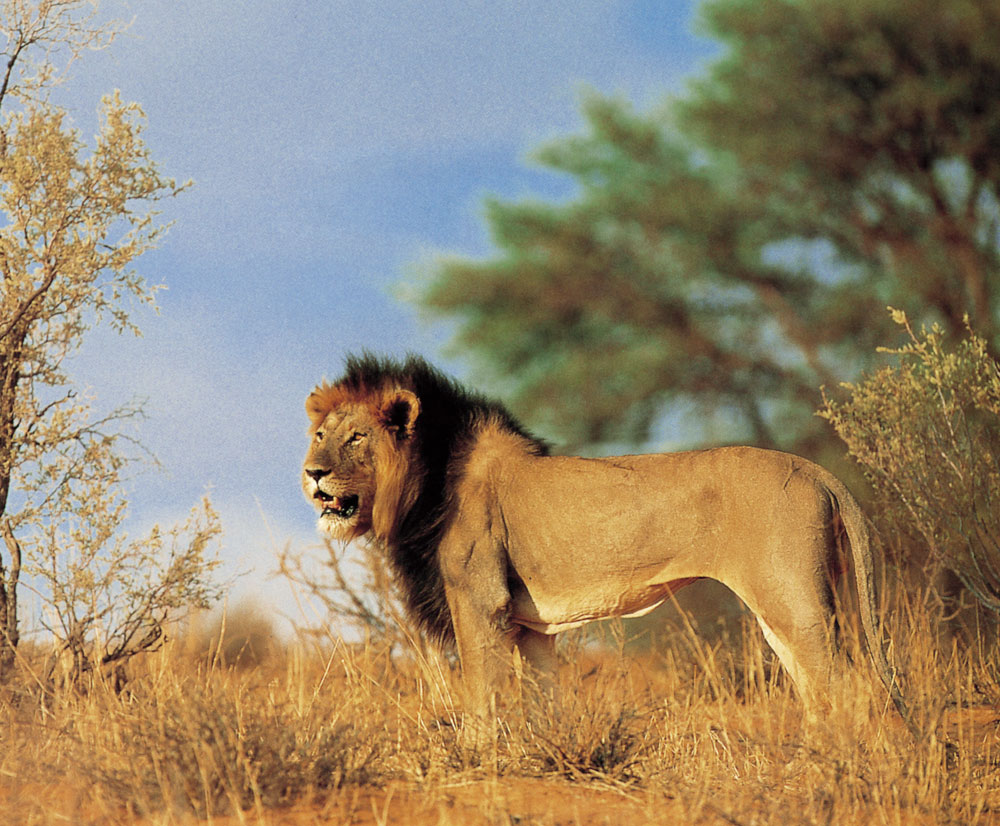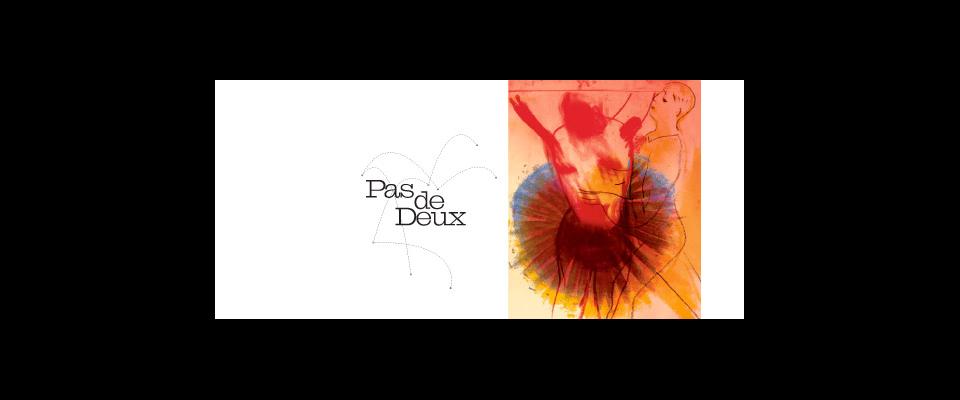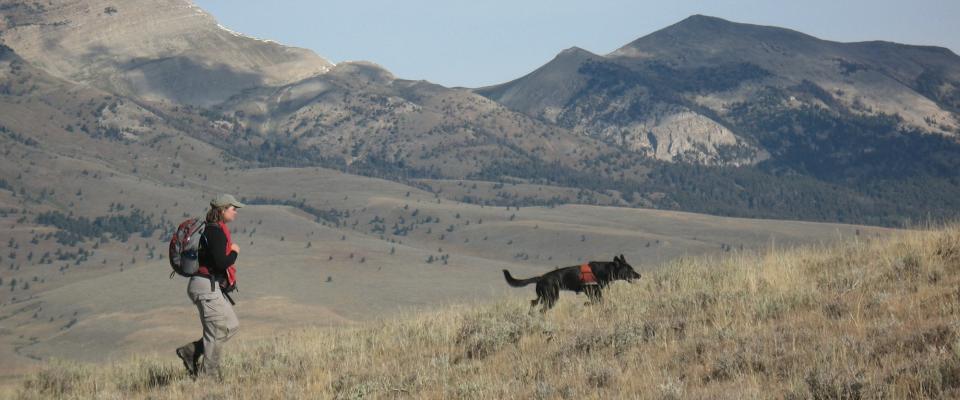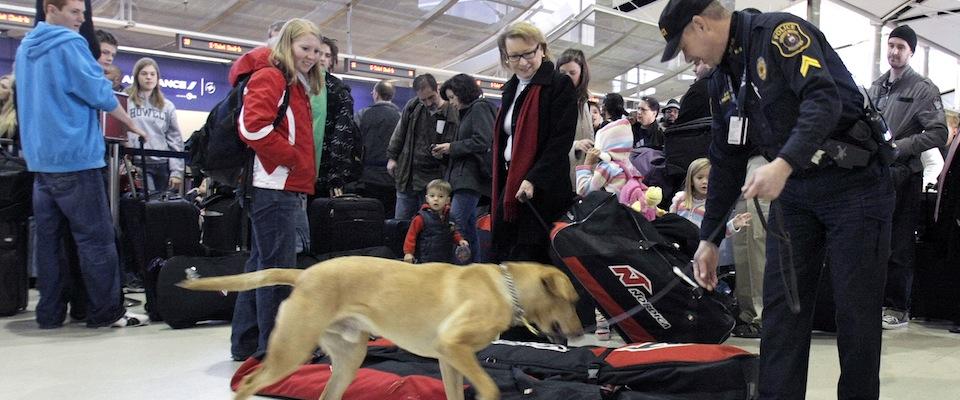Philosopher Alva Noë choreographs the mind.
On a stage in Frankfurt-am-Main, Alva Noë is pacing. Back and forth, talking about … dogs, but we don’t know why. The more he says, the stranger the experience seems.
The yellow dog is up. The blue dog is down! The red dog is up. The green dog is down. What are these dogs doing? There are dogs everywhere. Big dogs and little dogs in CARS! Riding around and driving around. There’s a dog out of a car. Why is the dog out of the car? Six dogs in a helicopter zooming around! Four dogs having a party in a boat! On a lake! At night. With a guitar!
Dogs! Dogs! Dogs!
Odd spotlights poke through the blackness. A woman appears. Tall. Svelte. Eyes large.
“Do you like my hat?” Noë asks. His head is bare. She looks at him with no particular regard and speaks, her English lightly seasoned with an accent from somewhere East.
“No. I do not like your hat. Goodbye.”
“Goodbye,” he answers.
Usually, Alva Noë walks and talks and paces in a classroom. At the Berkeley campus. He teaches philosophy. And he battles with brain scientists.
For the first time in 40 years, however, Noë is on a stage. With two chairs. With a dancer. Nicole Peisl. Who performs in Austria. And in Amsterdam.
They have been running a workshop entitled “Being Present/Making Present” with students from Germany, Paris, and Japan. The object is to explore perceptual consciousness, combining both the principles of cognitive science and techniques of touch to intensify their sense of action and movement as dancers.
This night, Noë and Peisl are performing for the students and for friends, and the public and other dancers, and for their own discovery. They’re in a seven-story soap factory that was preserved as an historic monument and then re-imagined as an art space when the soap business went away in a global industrial gobble.
Alva Noë finds in dance—or more precisely, in choreography—the essential puzzle of what it is to be a conscious human being.
The morning after his adult debut in front of stage lights, we spoke about how dance and philosophy and brain science have become intertwined in his working and thinking life.
“Dance is a research for me at so many levels. At one level because I think of human consciousness as something we achieve, as something we enact, through our dynamic of interaction with the world. Dance is a perfect metaphor for what our whole perceptual lives are like. It’s a two-way ongoing dynamic exchange in contrast, say, with digestion, which happens in me.” He pauses and looks straight into me, the philosopher to the student as it were, to be sure that I get the point. “Consciousness is not something that happens in us. It’s something we do.”
The stage performance he and Nicole Peisl were mounting, both described as aimed at bringing the audience inside a performance. Noë says, “I wanted to introduce the topic of the play,” whose title is What We Know Best, A Work in Progress.
“In the dog sequence we were naming what there is—as in a children’s book, or as in the Bible—and introducing the audience to a world. I began with mere repetition of the word dog out of context. Dog. Dog. Dog. Dog. It’s impossible to understand a word out of context. Meaning comes from context. We were trying to evoke the idea that a lot of stage setting is required even to hear each other, to make sense of each other.”
Pretty standard stuff, you might say. Take a scene from a children’s text (like Clifford the Big Red Dog). It has no meaning standing alone but gradually makes sense through tone of voice, expression, gesture. All these affect how we hear and comprehend what someone says to us, and influences whom by extension we believe that other person to be, as well as whom that other person understands us to be. But what may seem obvious to the average person doesn’t necessarily reflect how scientists interpret reality. Myths, children’s stories, parables, even particular words have in themselves no inherent meaning, Noë argues, until we hear and use them through interaction with others.
Noë began his professional life as a philosopher of science, working closely with neuroscientists, who increasingly have looked to the brain as the seat of consciousness. The flourishing of functional magnetic resonance imaging as a way of spotting everything from pleasure and pain centers to motor function and perceptual capacity has led more and more scientists to understand conscious existence as located exclusively within our brains—or, to recall a great phrase used by modern-day Cartesian skeptics, we human beings are little more than “a brain in a vat” of flesh and blood.
In his new book, Out of Our Heads: Why You Are Not Your Brain, Alva Noë takes aim at the growing movement among those neuroscientists who assert that our being exists wholly within the synaptic architecture of our gray matter. Citing the brain’s enormous plasticity, or ability to rewire its internal functions, Noë insists that neither meaning nor consciousness nor perception can possibly exist wholly inside the brain.
He points out that ferrets that have had their sight linkages transferred to the part of the brain normally associated with hearing—or their hearing wiring re-attached to sight centers—can see and hear perfectly well, depending upon the age of the ferret. Therefore, he reasons, the brain on its own cannot perceive sound or sight until the creature has interacted with the outside world. He cites the example of cats that have neurologically normal sight functions but never develop the ability to see if raised for their first three months in the dark.
Sight and hearing consciousness, then, he insists, do not exist solely within the brain, but in the brain’s contact with the outer world. That is why he finds dance and choreography better metaphors for how we humans come to be in the world.
Confronted by the fundamental puzzle that philosophers face—What am I? How can I be?—he finds in choreography a parallel form of puzzle solving: organizing events in time and space for others to understand. “Performers always have a problem to solve. They have to get from point A to point B. They have to do something. They have to act. And they have to act in a communicative setting. They have to show something. Or maybe they want to hide something. Or maybe they want to indirectly show something. The thing that’s distinctive about performance is that there’s a display taking place.”
In Noë’s view, we only become who we are and even begin to understand who we are through our performative action in the world. To be alive is to perform. To perform is to show. To show, in its most elemental sense, is to dance.
Here in France, where I live, I took these propositions to choreographer Michel Eghayan and his good friend, neuroscientist Marc Jeannerod, who work together in Lyon. Eghayan studied with the late Merce Cunningham in the 1970s.
“I used to say I was born twice. The first was a long time ago in France. The second time was in New York when I arrived in 1973 to work with Merce Cunningham. It was gorgeous, and that saved my life.” Trained in France in what he calls a frozen school of classical ballet, Eghayan still pays homage to Cunningham’s radical “neuroesthetic” definition of dance: “Merce said when you walk and you know that you walk, you are dancing. Consciousness of moving makes dance.”
The piece Eghayan’s troop is rehearsing when I arrive is called Which Side Story. It’s a work with modest ambitions. Using light, shadow, movement, and video, it traces the history of everything that has ever moved, from the first bacteria to the Sun’s ultimate implosion into a black hole.
The dancers are young—even so, you could imagine that the contortions through which they move would soon land them in the orthopedic ward. I sit in the first row with neurologist Jeannerod, who leans over and whispers, “All those movements are unnatural. You have to learn them to adapt your body. It’s a challenge for equilibrium. We never do that in ordinary life. [It’s] mental and physical. You have to encode these movements into mental processes and then you can use your mental knowledge …. Most of these people, they rehearse mentally.”
He pauses for a second and adds with a smile, “It’s a question of brain training.”
Muscle training, joint training, tendon stretching: These I understand, just as I understand that learning multiplication tables and quadratic equations would be brain training. But the notion that dancers are engaged in “brain training” at first seems strange. What could be more patently physical than dance?
During a rehearsal break, we step outdoors to take in the late autumn sun, and Jeannerod elaborates. If you have learned something, he says, you have a mental template in your brain of how to move, or if you make music, you transfer the music that you have to rehearse to your brain, and then you replay it in your head. When you replay, or think an action, this will activate the same areas that you activate when you make the movement. Thinking about the movement and making the movement are more or less the same thing.
“If I move my fingers in my right hand, and you put me in a scanner, you will see that the motor cortex on the left side is activated. Now if I think of moving my fingers, the same area will be activated. A little less, but same areas.”
“Are you saying a dancer can rehearse on the subway train on the way from home to the studio?” I ask.
“Absolutely. Singers rehearse their songs mentally to spare their voices. Musicians do that in planes. The violinist will rehearse his performance like that, and dancers as well. That was first formalized in sports … like downhill skiing. They all rehearse mentally before they do it. The day before, the night before, the morning before. I think all sportsmen do that. They don’t know they do it, but they just think about the movement. Then when you make the movement, it is more efficient.”
These mental rehearsals or remembrances take place in what neuroscientists call our “mirror neurons”—neurons adjacent to the actual motor centers in our brain that are critical to physical learning. Eghayan, who joins us during the break, tells how Jeannerod had illustrated physical “brain training.” He brought a set of high-resolution video cameras to the studio to record a ballerina who would hold her legs stretched tight, seeming to the audience’s eyes absolutely still. Then he replayed the video highly enlarged.
Eghayan recalls, “‘Look at her!’ he told us. She was moving a little bit even if she seemed still, because the body adapts always. Nothing is still. Everything is moving. This is the reality of balance.”
When we are standing upright, Jeannerod says, we are always like an inverted pendulum in perpetual oscillation, incapable of being still: “The role of the brain is to permanently monitor the center of mass of the body and to introduce minimal corrections with leg muscles, so that you minimize the oscillations on the ankles.”
Classical dance teachers in Eghayan’s youth told him that he had to learn how to remain absolutely motionless. “The teachers used to say, ‘Stretch your body and hold your balance like that!’ And I feel the contrary, the opposite. And Marc Jeannerod showed me that I was right, that my feelings, my practice, my intuitions were right!”
Most of us think we already know that, but Eghayan and Jeannerod’s examples illustrate Noë’s fundamental philosophical argument: The conscious living organism is and must always be engaged in an interactive dialogue with the world beyond itself. Even to lie in bed “absolutely still” rehearsing a double arabesque in your mind, you must have witnessed or practiced that movement before, and therefore it cannot be created solely within the brain.
Another French neuroscientist, Julie Grèzes in Paris, has illustrated the latter by recording the motor centers in the brains of classical dancers as they watch capoeira, the popular Brazilian martial-arts dance. When classical dancers watch a classical repertoire, their motor centers will activate. But when they watch somebody doing capoeira, their brains will not activate as strongly because the dancers have not encoded these movements in their own repertoires. “Of course he could do it if he learned capoeira,” Jeannerod adds, “but the first time, it doesn’t mean anything.” Meaning arrives, he explains, by encoding the brain.
These dance illustrations cut to one of the oldest debates in philosophy and recall the most famous dictum in Western ideas: Descartes’s “Cogito ergo sum,”—I think; therefore I am. Conscious existence, the reality of the mind, in the Cartesian formulation is a phenomenon inside the brain. All that we see, all that we hear, all that we do, all that we can know is a creation of the synaptic mechanisms that make up our brains. The preponderance of contemporary neuroscience, indeed the fascination with the mysterious powers of the brain to create new insights, find root in that Cartesian kernel.
Many leading philosophers, not least Noë’s Berkeley colleague, John Searle, would largely agree: All that we as subjective agents can perceive are the electrobiological signals that fire inside our brains, not the actual physical objects themselves. Politely but forcefully, Alva Noë and his camp disagree. Although he credits Searle in the Acknowledgments of his book as a critic he admires, Noë argues that Searle is fundamentally wrong and that his approach leads both to bad science and a mechanistic reduction of human consciousness.
“I think it’s possible,” Noë told me over coffee the morning after his Frankfurt show, “to be a human being and not know you have a brain. And the reason I say that is that we just don’t live in reference to our brains. Our whole bodies do show up for us, and even our heart shows up for us, but the brain is sort of … it’s behind us, behind the eyeball. It’s not something we experience.”
It is, he added, a causal precondition of our experience. “I think that performance, or all life, is that which is undertaken by the whole embodied animate organism situated in a dynamic situation. Neither literature, nor art, nor politics, nor love have the brain as their concern.”




















